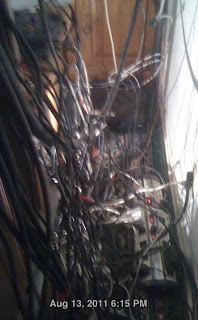After several frustrating and backbreaking hours trying to install this outlet while crouching under the table, I've decided to get an electrician to do it. I've booked my favorite electrician (the best contractor of any kind I know right now) to do it. The earliest he is available on Monday, which now makes it impossible for me to complete the under table redesign before the end of the following weekend.
Unlike any other outlet I've ever seen, the 5262-A has a wire cage design; beneath the hot and neutral terminals there is a pressed metal cover that is apparently intended to go on the outside of the wires, so each wire is trapped in between a brass plate on the side of the outlet body the cover. In a typical outlet, a terminal screw holds each wire down. But the the screw doesn't provide as good contact as the wire cover, it tends to pull on the wire when it is tightened, and if the screw becomes loose over time the wire can pull out.
In this and every other way, the 5262-A is the most robust electrical outlet I've ever seen, and fully deserved selection as "the best" by the late and legendary Bob Crump. Unfortunately it is not longer in production.
But the wire cage is an obstacle to installation for nonpro electrical installers like me. How are you supposed to get a 14G solid wire in there? Possibly if you could curve the wire with just the right curve beforehand, you could do it. But unlike most outlets, you cannot simply wrap the wire around the terminal and force the wire into place (a crude but effective method usually, though sometimes small chinks of plastic break off the outlet, so it doesn't exactly seem that is the correct method.
Another method might be to remove the screw terminal first. then wrap the wire around the screw, then put the wire cover under the screw and screw the entire assembly (wire, cover, screw) down in the outlet. That's what I finally attempted to do.
But nobody has ever told me that you could reversibly remove the terminal screws from an electrical outlet. As you turn the screw towards out, it sticks rather hard, as if it's not supposed to be turned anymore, so I've never done that before. I was a little worried about doing things this way without official instructions (no instructions were included with my NOS P&S outlets).
Whether the removing-the-screw-first technique is AOK or not, it's not easy to get the screw back in. I was able to do this on the hot side, but many attempts to get the neutral screw back in failed. I somewhat damaged the screw cap and may also have damaged some of the screw threads in the process. It was at that point I decided I needed a pro to do this. A pro could probably do this all in a few minutes without damaging the threads. Fortunately the outlet has two sets of screws, and I have not messed with the lower set.
A friend of mine did not want me installing electrical outlet anyway. I told her I'm extremely careful about everything and I've done it before thirteen times. Actually, I think I'd done it about a dozen times, this being the thirteenth.
I feel bad about not being able to finish the under-table rework during my vacation. But there was another iffy part also. Installing the new security camera will require a hole in the upper back corner of the kitchen. That location is completely inaccessible by ladder without removing the satellite TV box, and probably the rest of the under-table stuff as well. So, if I had gotten everything set up without getting the camera in place, I'd simply have to remove everything all over again.
And getting the camera installed posed some additional challenges. A through-wall hole is required, and I am loathe to do those. I'm always worried about hitting electrical lines with my drill. And my 6' ladder, which I'd need to use on the outside while mounting camera (though a taller ladder would be better) is especially wobbly. And I'm still using a rental car which is not a hatchback, so it's not easy to buy and bring home a new 6' ladder. I was hoping I'd get my car back from the shop on time to buy a new ladder and do the camera install before the end of the weekend. But it's already Thursday and no word about picking up my car yet.
Even if I got a new ladder, the 6' really wouldn't be tall enough, though it's the biggest I can get into hatchback, and I was wondering if I'd actually be able to do the camera install myself. I was thinking it wouldn't be a bad idea to get electrician to do that. There are many issues, such as sealing the outside, getting a nice wall cover set up on the inside, etc, any one of which looked like it might be very difficult for me to do.
So now I'm hoping to get my electrician do these two things, both camera install AND new outlet, both of which would really need to be done before getting everything set up again. And it's probably all for the best that things have worked out this way, even if not following plan and my projected completion date slips.











